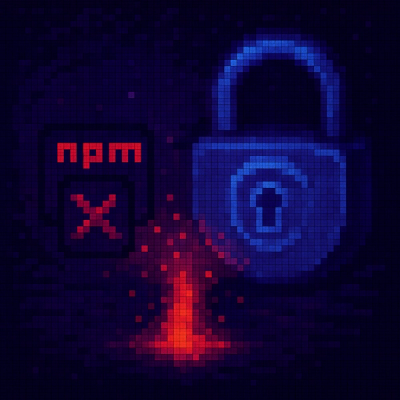
Security News
Software Engineering Daily Podcast: Feross on AI, Open Source, and Supply Chain Risk
Socket CEO Feross Aboukhadijeh joins Software Engineering Daily to discuss modern software supply chain attacks and rising AI-driven security risks.
UDPComms
Advanced tools
This is a simple library to enable communication between different processes (potentially on different machines) over a network using UDP. It's goals a simplicity and easy of understanding. Currently it works in python 2 and 3 but it should be relatively simple to extend it to other languages such as C (to run on embeded devices) or Julia (to interface with faster solvers).
The library automatically determines the type of the message and trasmits it along with it, so the subscribers can decode it correctly. While faster to prototype with then systems with explicit type declaration (such as ROS) its easy to shoot yourself in the foot if types are mismatched between publisher and subscriber.
Note that this library doesn't provide any message security. Not only can anyone on your network evesdrop on messages they can also spoof messages very easily.
$pip3 install UDPComms :)
Note that if you have an old version of the library installed (before we setup installing via pip) you'll have to uninstll that version manually by removing it from the site-packages folder inside your distribution. See this StackOverflow question. Alternativly you could use virtual environments to avoid this.
>>> from UDPComms import Publisher
>>> a = Publisher(5500)
>>> a.send({"name":"Bob", "age": 20, "height": 180.5, "mass": 70.1})
TLDR - you probably want the get() method
Note: before using the Subsciber.recv() method read about the Subsciber.get() and understand the difference between them. The Subsciber.recv() method will pull a message from the socket buffer and it won't necessary be the most recent message. If you are calling it too slowly and there is a lot of messages you will be getting old messages. The Subsciber.recv() can also block for up to timeout seconds messing up timing.
>>> from UDPComms import Subscriber
>>> a = Subscriber(5500)
>>> message = a.recv()
>>> message['age']
20
>>> message['height']
180.5
>>> message['name']
"Bob"
>>> message
{"name":"Bob", "age": 20, "height": 180.5, "mass": 70.1}
The preferred way of accessing messages is the Subsciber.get() method (as opposed to the recv() method). It is guaranteed to be nonblocking so it can be used in places without messing with timing. It checks for any new messages and returns the newest one.
If the newest message is older then timeout seconds it raises the UDPComms.timeout exception. This is an important safety feature! Make sure to catch the timeout using try: ... except UDPComms.timeout: ... and put the robot in a safe configuration (e.g. turn off motors, when the joystick stop sending messages)
Note that if you call .get immediately after creating a subscriber it is possible its hasn't received any messages yet and it will timeout. In general it is better to have a short timeout and gracefully catch timeouts then to have long timeouts
>>> from UDPComms import Subscriber, timout
>>> a = Subscriber(5500)
>>> while 1:
>>> try:
>>> message = a.get()
>>> print("got", message)
>>> except timeout:
>>> print("safing robot")
Although UDPComms isn't ideal for commands that need to be processed in order (as the underlying UDP protocol has no guarantees of deliverry) it can be used as such in a pinch. The Subsciber.get_list() method will return all the messages we haven't seen yet in a list
>>> from UDPComms import Subscriber, timout
>>> a = Subscriber(5500)
>>> messages = a.get_list()
>>> for message in messages:
>>> print("got", message)
port
The port the messages will be sent on. I recommend keep track of your port numbers somewhere. It's possible that in the future UDPComms will have a system of naming (with a string) as opposed to numbering publishers.scope Scope.LOCAL will only send messages to only this computer. Scope.NETWORK will to send to others on the network. See Scopes explained for details.port
The port the subscriber will be listen on.timeout
If the recv() method don't get a message in timeout seconds it throws a UDPComms.timeout exceptionscope There is currently no difference in behaviour between Scope.LOCAL and Scope.NETWORK - both will receive any messages that get to the device. This is planned to change in the future and Scope.LOCAL will only receive local messages.The protocol underlying UDPComms - UDP has a number of differnt options for how packets can be delivered. By default UDPComms sends messages only to processes on the same device (Scope.LOCAL()). Those are still sent over multicast however the TTL (time to live) field is set to 0 so they aren't passed to the network. To send messages to other computers on the same network use Scope.NETWORK(). This will default to using the multicast group 239.255.20.22.
Older versions of the library defaulted to using a broadcast on the 10.0.0.X subnet. However, now that the library is often used on differnt networks that is no longer the defualt. To emulate the old behvaiour for compatibility use Scope.BROADCAST.
Both the multicast group and the broadcast subnet can be changed by overwriting the class varaibles MULTICAST_IP and BROADCAST_IP respectivly.
Here are all the avalible options:
Scope.LOCAL - Messages meant for this device onlyScope.NETOWORK- Messages meant for the specified multicast groupScope.BROADCAST - Messages meant for all devices on this subnetIf you want to talk to devices aross the internet use RemoteVPN to get them all on the same virtual network and you should be able to use Scope.Multicast() from there
This repo also comes with the rover command that can be used to interact with the messages manually. It doesn't get installed with pip but its here. It depends on the pexpect package you'll have to install manually
| Command | Descripion |
|---|---|
rover peek port | print messages sent on port port |
rover poke port rate | send messages to port once every rate milliseconds. Type message in json format and press return |
There are more commands used for starting and stoping services described in this repo
Macs have issues sending large messages. They are fine receiving them. I think it is related to this issue. I wonder does it work on Linux by chance (as the packets happen to be in order) but so far we didn't have issues.
Messages over the size of one MTU (typically 1500 bytes) will be split up into multiple frames which reduces their chance of getting to their destination on wireless networks.
FAQs
Simple library for sending messages over UDP
We found that UDPComms demonstrated a healthy version release cadence and project activity because the last version was released less than a year ago. It has 1 open source maintainer collaborating on the project.
Did you know?

Socket for GitHub automatically highlights issues in each pull request and monitors the health of all your open source dependencies. Discover the contents of your packages and block harmful activity before you install or update your dependencies.

Security News
Socket CEO Feross Aboukhadijeh joins Software Engineering Daily to discuss modern software supply chain attacks and rising AI-driven security risks.

Security News
GitHub has revoked npm classic tokens for publishing; maintainers must migrate, but OpenJS warns OIDC trusted publishing still has risky gaps for critical projects.

Security News
Rust’s crates.io team is advancing an RFC to add a Security tab that surfaces RustSec vulnerability and unsoundness advisories directly on crate pages.